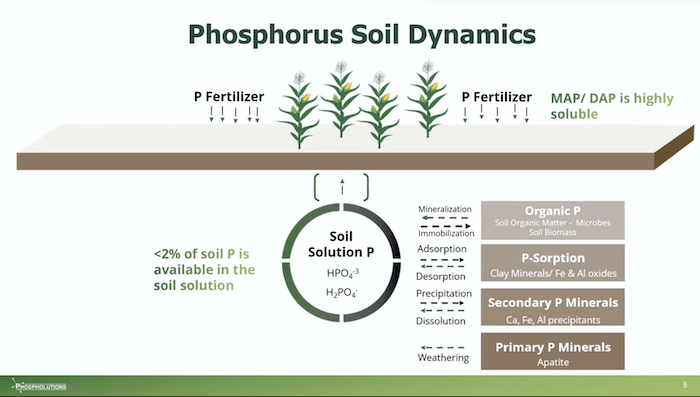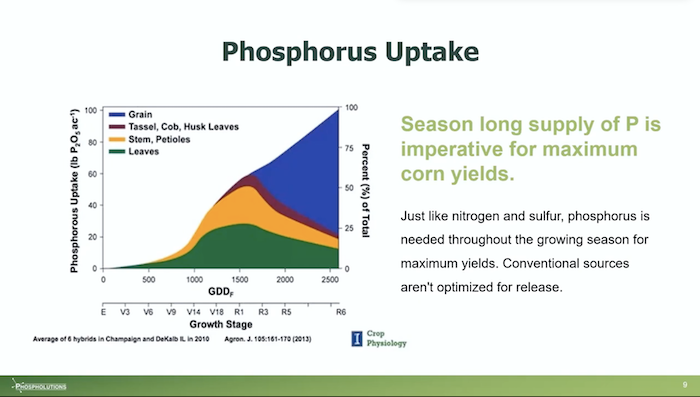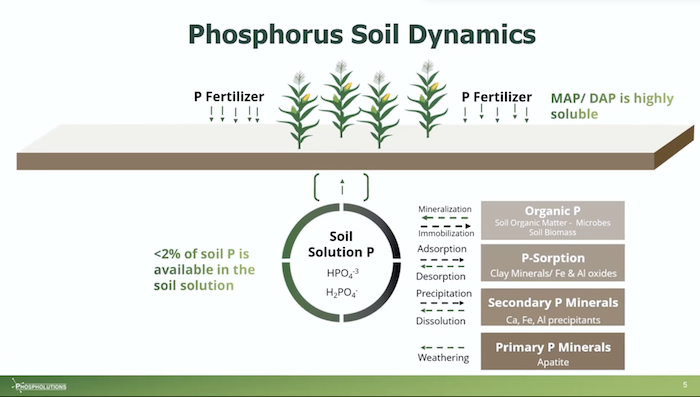Phosphorus (P) is critical to growing high-yielding crops, but putting more P on the field isn’t necessarily the solution.
Brian Reineke, director of agronomy at Phospholutions, says only 10-30% of applied P fertilizer is taken up by the crop each year. On top of that, less than 2% of soil P is actually available to the crop due to natural soil dynamics.
“Commercial MAP and DAP are very highly soluble materials in excess water and moisture,” Reineke says. “This is a good thing until soil chemistry takes over. These materials are highly reactionary to other soil constituents like calcium and magnesium in higher pH ranges, and aluminum and iron in lower pH ranges. P is either going to be mineralized or solubilized and immobilized.”
Reineke says the crops only absorb what is made plant available by chemical and biological actions when there is adequate moisture throughout the growing season. As an immobile nutrient — and one that’s easily tied up — available P in the soil solution becomes a limiting factor early and late in the season.

Brian Reineke, director of agronomy at Phospholutions, says only 10-30% of applied P fertilizer is taken up by the crop each year.
How Crops Take Up Phosphorus
Diffusion, the movement of molecules through the soil, is the primary way crops take up P, according to Reineke. 92% of P uptake comes from diffusion, compared to just 3% taken up through contact with roots.
“Having a clear understanding of our soil test and crop demands bridges the gap to what the soil can physically provide to what the crop is needing during the season,” Reineke says. “Plant demand for P skyrockets when the plant moves from vegetative to reproductive growth, so it’s important to start out strong early with good available soil solution P levels.”
It’s also important to maintain P availability later in the season. Reineke says research from Fred Below at the University of Illinois shows P is more than 75% of the contribution to grain and yield.

research from Fred Below at the University of Illinois shows phosphorus is more than 75% of the contribution to grain and yield.
But overapplying P isn’t the answer to having enough of it available throughout the entire growing season. Jonathan Lynch at Penn State University studied the overall concentration P on root architecture, and he found more P doesn’t corralate with more roots. In fact, excessive P can reduce mass and size of root growth in the soil.
“It’s vital to high yield and high-quality crops that we get the P application and the rate correct so we stop overapplying P as a main strategy to overcome MAP and DAP’s inefficiencies,” Reineke says.
RhizoSorb Solution
Phospholutions’ method to address that problem is RhizoSorb, a new additive that makes P fertilizers more efficient by improving anionic nutrient exchange in the soil. The dry granulated fertilizer is a 8-39-0 product comparable to conventional MAP. It can be broadcast or banded.
Reineke says RhizoSorb maintains or improves yield with 50% less applied P and reduces runoff by 58%. This results in a 10-15% decrease in cost of phosphates on a per-acre basis.
“When you’re using RhizoSorb, even at lower rates, we’re confident that it’s getting into the crop and thus moving P through its plant life cycle to give you the end result of yield,” Reineke says.
Phospholutions tested RhizoSorb across 200 trial locations across 14 states. Reineke says trials produced positive yield results in corn 85% of the time and a 4.9 bushel per acre advantage with 50% less P. Soybean trials reported a 76% success, which represents a 1.6 bushel per acre advantage from using RhizoSorb and 50% of the farmer’s standard P rate.
“With the reduction in P from RhizoSorb, we were maintaining or had an increase in the actual average percent of P utilization,” Reineke says.
Watch No-Till Farmer’s webinar with Reineke for more information about the trials and RhizoSorb.
Related Content
Improving Growers' Bottom Line and Phosphorus Uptake with RhizoSorb Fertilizer
Phosphorus, Potassium Fertilizer Recommendations For High-Yielding Soybeans
Insights into Grain Phosphorus and Potassium Numbers







Post a comment
Report Abusive Comment